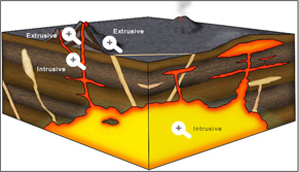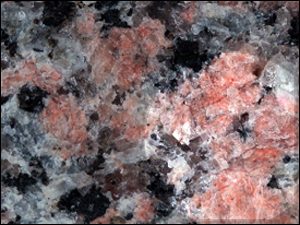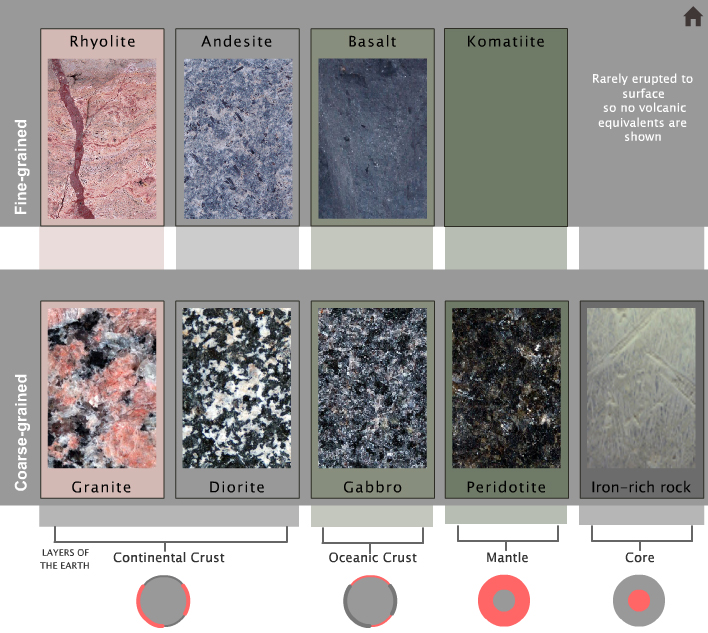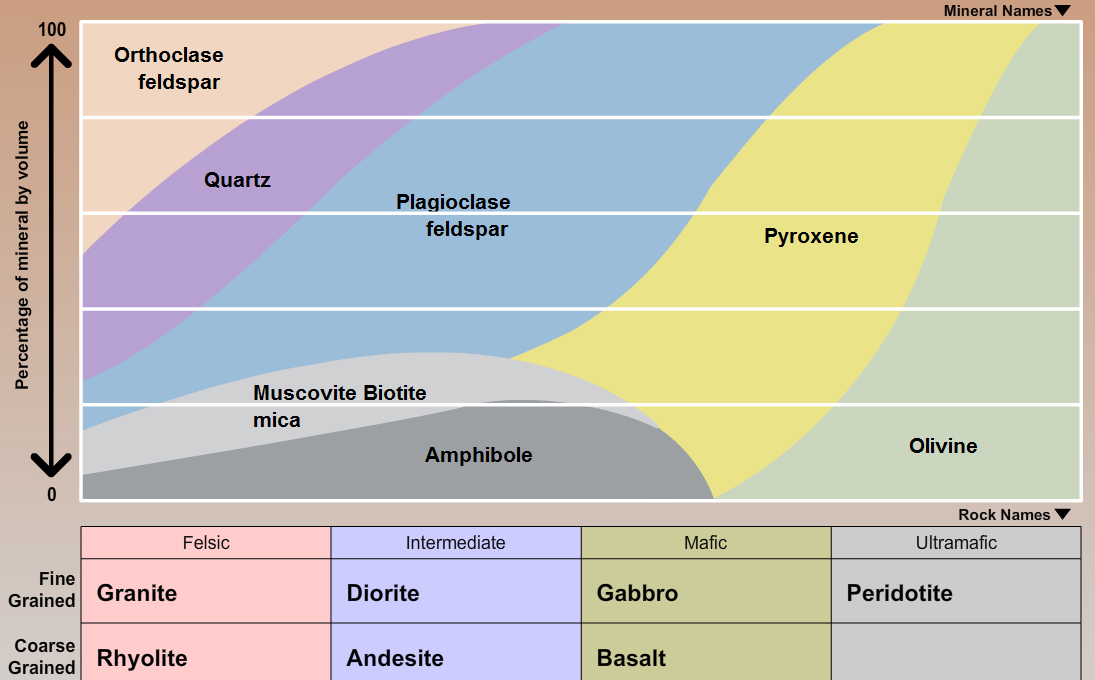
"Did you have a nice weekend? We added a few things for you here and there.
Do you like our little game. Will you conquer Stations 4-7?
Let's get to it! - the Earthlings
p.s. Questions are in BLUE. Links are in ORANGE.

Observe each object at this station and decide whether it is a rock or not.
Base your decision on the definition of "rock."
For your science notebook:
1a. Make a list of the objects at this station and write down whether it is a "Rock" or "Not a rock."
1b. Explain in writing why each object that is "Not a rock" is not a rock.


Observe each rock and decide whether it is igneous in origin. Base your decision on what you already know about igneous rocks.
You'll look at these later and see how much you've learned!
For your science notebook:
2a. Make a list and write down why each of these rocks is, or is not, igneous in origin.


Observe each set of rocks and objects and explore how atoms, crystals, minerals and rocks are related.
For your science notebook:
3A.a Which sample has the fewest number of crystals?
3A.b Which sample has the greatest number of crystals?
3A.c How many types of minerals are in Sample #2?
3A.d About how many crystals are in Sample #1?
3A.e Which sample has the greatest number of minerals?
Link:
How and where mineral crystals grow as igneous rocks form.

Link:
Two adjacent crystals of the same type.

 :
:
For your science notebook:
3B.a What's the smallest thing you can think of?
Atoms are probably smaller thann anything you can imagine.
3B.b Observe Sample #1, the mineral called halite, and describe the shape of the individual halite crystals. Use the hand lens to take a good look.
Halite is the mineral name for everyday table salt.
3B.c Observe the online 3-D model of halite and build your own model using the available parts.
Rotate the online 3-D model by dragging your cursor over the image. Take a good look and figure out the pattern in which the atoms are arranged.
The purple and green spheres represent (stand for) atoms of sodium (Na for short) and chlorine (Cl for short).
To be called the mineral halite, the atoms inside it must be sodium and chloride, and they have to be arranged in this pattern. When you snack on a salty treat, you're consuming these atoms.
3B.d Do you think that the shape of halite crystals are related to the pattern of the atoms inside? Write down what you think.
 :
:

3B.e Can you name the two most common types of atoms in the Earth's crust and mantle?
Although most of us use halite everyday, sodium and chlorine are NOT the most common type of atoms that make up the Earth.
3B.f Observe Sample #1-the silica tetrahdron and draw its structure.
The silica tetrahedron is a structure made up of one silicon atom attached to four oxygen atoms. Most minerals in the Earth's crust and mantle are made up of this structure. The mineral quartz is made up of many of these tetrahedra connected to each other Depending on the pattern in which they are connected, the crystal shape and properties of various minerals differ.
3B.g Observe the online 3-D model of quartz and write down the names of the types of atoms in this mineral. Can you find individual tetrahedra in the 3-D model? Drag on the model to rotate it. Since the names of the types of atoms are written in shorthand, you will need to look up the names of the atom on the link to a list of types of atoms.
3B.h Observe the online 3-D model of the mineral muscovite mica and describe what you think this mineral might look like in person.
The mineral muscovite is also made up of the silica tetrahedra.
Drag your cursor over the model to rotate it and take a good look.
The lines between the atoms show places where the atoms are attached to each other.
Atoms are not held together by ultramicrosopic sticks. These lines represent invisible forces that bond these atoms.
The areas with no lines are places where the forces of bonding are weak.
3B.i Observe the online 3-D model of the mineral plagioclase feldspar. Besides silicon and oxygen, what kinds of atoms are found in plagioclase feldspar?


Observe each set of minerals and analyze special features described below.
Explore the properties of minerals
Some minerals are harder than others.
The property of hardness refers to relative ability to scratch other materials, not whether a mineral will break if struck with the other like a hammer.
Relative hardness can be a clue to identification of a mineral because hardness is a fixed property of minerals. Quartz always scratches glass and feldspar. Try scratching the glass plate with quartz - Sample #2.
For your science notebook:
4A.1 Does the mineral calcite - Sample #3 scratch glass?
4A.2 If a mineral scratches quartz, will it scratch glass?
4A.3 If you choose a mineral to use as a gemstone, would you pick one with a low or high hardness? Explain why.


Some minerals have a property called a "streak." Streak is the color left by the mineral when dragged along a piece of unglazed porcelain. The color of streak can help to identify minerals, particularly metallic minerals. Some metallic minerals leave an unexpected streak color.
For your science notebook:
4B.1 What color is the streak of pyrite - Sample #1?
4B.2 What color is the streak of quartz - Sample #2?

Crystal form refers to the for or outer shape of crystals. For example halite assumes a shape like a cube under ideal circumstances. So a mineral that has a cube shape might be halite. But it also might be galena or fluorite too. Many mineral crystals can assume several related shapes. Each mineral is limited in the range of shapes it can assume by the hidden internal arrangement of atoms.
For your science notebook:
4C.1 The mineral halite looks like a cube. Which of the samples also looks like a cube?
4C.2 If two minerals have the same crystal form, can crystal form be used to tell those minerals apart (to distinguish them)? If not, how else would you try to distinguish them?
4C.3 When minerals grow in a magma, they add atoms to their outer edges of each crystal in the patterns you saw or will see at Station 3. Why do you rarely see perfectly shaped crystals in a rock like granite?

There are a few special features of some common minerals that are useful to know - striations and conchoidal fraction. Plagioclase feldspar, the most common mineral in the Earth's crust exhibits striations. Quartz, the second most common mineral in the Earth's crust exhibits conchoidal fracture.
For your science notebook:
4D.1 Observe Sample #1 and find the striations. Look for the very straight lines on some of the sides of the plagioclase feldspar crystal. If you had incredibly tiny and sensitive fingers, you would feel the ridges of these very thin features. These are called striations. It is a very distinctive feature of plagioclase feldspar, but very difficult to find on small crystals.
4D.2 Observe Sample #2 and find the wiggly lines that are not striations. Look for wiggly lines of slighty darker and ligher pink. These wiggly lines of color that you cannot feel as surface texture are not striations. However, this pattern is highly indicative of the mineral potassium feldspar.
4D.3 Observe Sample #3 and find the straight lines on some faces of a quartz crystal. Quartz also has very straight lines with surface texture on same crystal faces. These are not striations. Since they look like striations, we want you to have this expert knowledge about quartz. How are these lines different than striations?
4D.4 Observe Sample #4 and find conchoidal fracture. Quartz also breaks with smooth arc-shaped surfaces like glass. This arc-shaped pattern is called conchoidal fracture.

For your science notebook:
4E.1 If you had two muffins, one with hidden gold chips inside, which do you pick - the one that is more or less dense?
You can't see the gold chips because they're on the inside and the two muffins are the same size. When you hold each of the muffins in your hand, one is much denser than the other.
If you had first pick, which muffin do you choose and why?
4E.2 Which is more dense - Sample #1 or Sample #2?
4E.3 Would a giant piece of Sample #2 - talc be weigh more than a little piece of Sample #1 - hematite?
4E.4 Would a giant piece of Sample #2 - talc be more dense than a little piece of Sample #1 - hematite?
4E.5 All the cubes in the box with Samples 3-6 are the same volume (size). Hold them in your hand and compare their relative weights. Weigh the piece of lucite - Sample #5 and the piece of steel - Sample #3
4E.6 Are all metals dense? Compare the densities of aluminum - Sample #4 and steel - Sample #3.
4E.7 Since atoms make up all materials, what must be true about the atoms inside materials that are denser?
The atoms inside the space of a certain mineral crystal are bigger and heavier. True or false?
The atoms inside the space of a certain mineral crystal can be the same size, but packed closer together so there are more in the same volume.. True or false?
4E.8 Which muffin to pick?
Now if you had two of these special muffins with gold chips,
1) a smaller one that is more dense but weighs less, and
2) a bigger one that weighs more but is more dense,
and you have first dibs, which do you choose?


Observe the 7 minerals that make up most igneous rocks. Most igneous rocks are made up of just 7 types of minerals. If you can recognize these 7 minerals, you can identify igneous rocks!
Different kinds of igneous rock contain different proportions of each mineral. Some of the minerals may be absent in a rock. Some of the minerals, such as quartz and olivine, are rarely be found together in the same rock.
To name your mystery rock, you will need to identify the minerals in your rock. You will be able to name your rock at Station 7 after you combine the mineral information (this station) with the texture of your rock (Station 6).
So look at the minerals at this station and learn to identify each.
For your science notebook:
5a. Observe each mineral and take notes on two or more properties (characteristics) that you can use to identify it later. You will see examples of different properties of minerals at Station 4. Make a list of the minerals and add at least two notes for each one.
5b. You cannot identify a mineral by just one property such as color. While certain minerals tend to come in certain colors, many different kinds of minerals. come in the same colors. For example, both quartz and feldspar can be white. Can both quartz and potassium feldspar be pink? Look at the examples on the online mineral diagram.
5c. How can you tell apart (distinguish) between quartz and plagioclase feldspar when both are white? Remember all the properties you learned about at Station 4.
5d. The properties of minerals are useful because they let you tell apart and identify different minerals. True or False?
5e. Because they are small, it is difficult to identify minerals in igneous rocks. If your mystery rock has crystals that are large enough to see, write down the names of the minerals in your rock. If the minerals are too small to see, write down "Too small to see."


Observe the different textures found in igneous rocks.
These textures is related to how each igneous rock formed.
The texture of your mystery rock is one of the keys to its identity.
The two keys to identifying your rock are its mineral composition (Station 5) and texture (this station).
For your science notebook:
6a. Observe each texture and describe the texture and what it tells you about how a rock formed.
6b. Name and describe the texture of your mystery rock.
The diagram "Naming igneous rocks" shows which textures and mineral compositions belong to which rock. Refer to this diagram to determine the name of your mystery rock.
For your science notebook:
7a. Recall the mineral composition you observed in your rock at Station 5 and write it down here.
7b. Recall the texture you observed in your rock at Station 6 and write it down here.
7c. Use the diagram "Naming igneous rocks" and "Igneous rocks" to determine the name of your rock based on its texture and mineral composition.
What is the name of your rock?


 Note to aliens:
Note to aliens:
We've made a map showing the places where igneous rocks are common.
Igneous rocks make up much of the Earth even though the surface of the Earth is covered in many places by a thin layer of sedimentary rock.
In some places, igneous rocks are exposed at the surface because volcnoes erupt at the surface.
But dig below the surface and you'll find igneous rock everywhere because magma solidifies underground.
But in special places, even rocks that had solidified underground can be exposed at the surface. When overlying materials are eroded away or worn away, even deep buried magma chambers can be exposed.
For your science notebook:
8a. Look at the map of "Places where certain igneous rocks are found on Earth."
Observe the places where your igneous rock might have been found.
Mark the places where your rock may have been found on your blank map by coloring in those areas. If it is a large area, use a light color so you can write over it later.
This is the first clue to where you landed. You will use two other clues to further narrow the places where you might have landed.
8b. Based on what you know about the Earth's tectonic plates, did your rock form at the boundary between plates or not?
8c. If your rock came from near a plate boundary, are the plates converging or diverging where your rock formed?
8d. Is any special tectonic activity taking place where your rock formed?